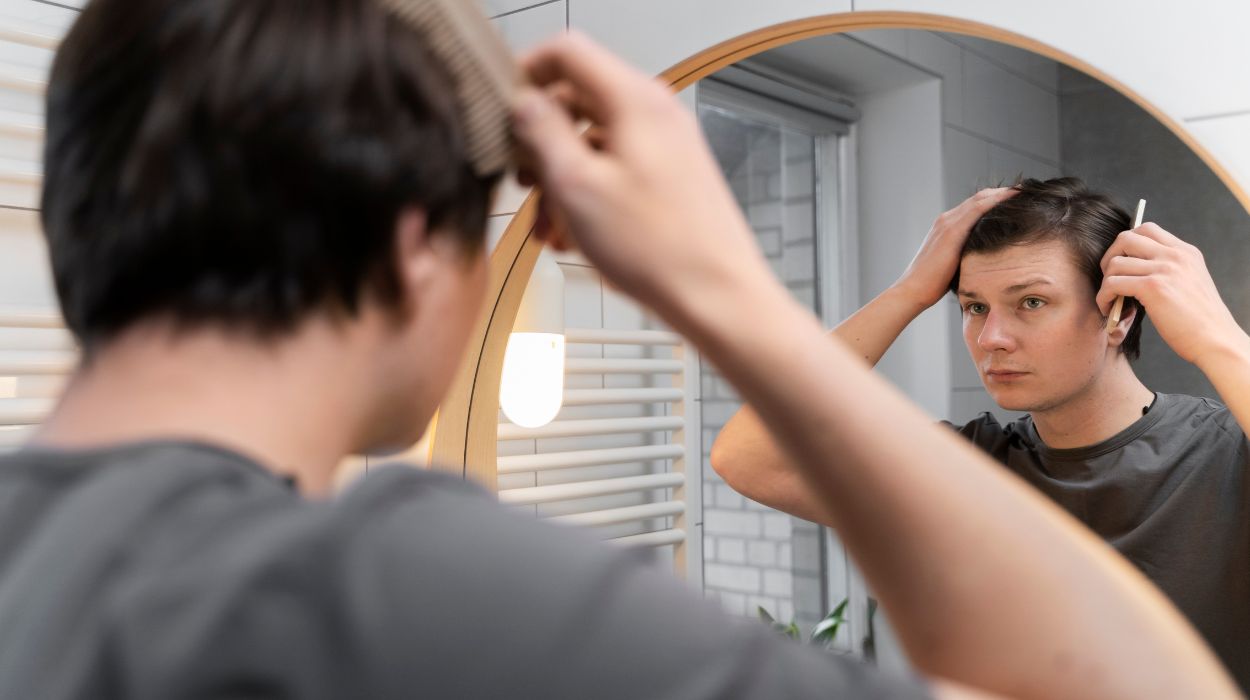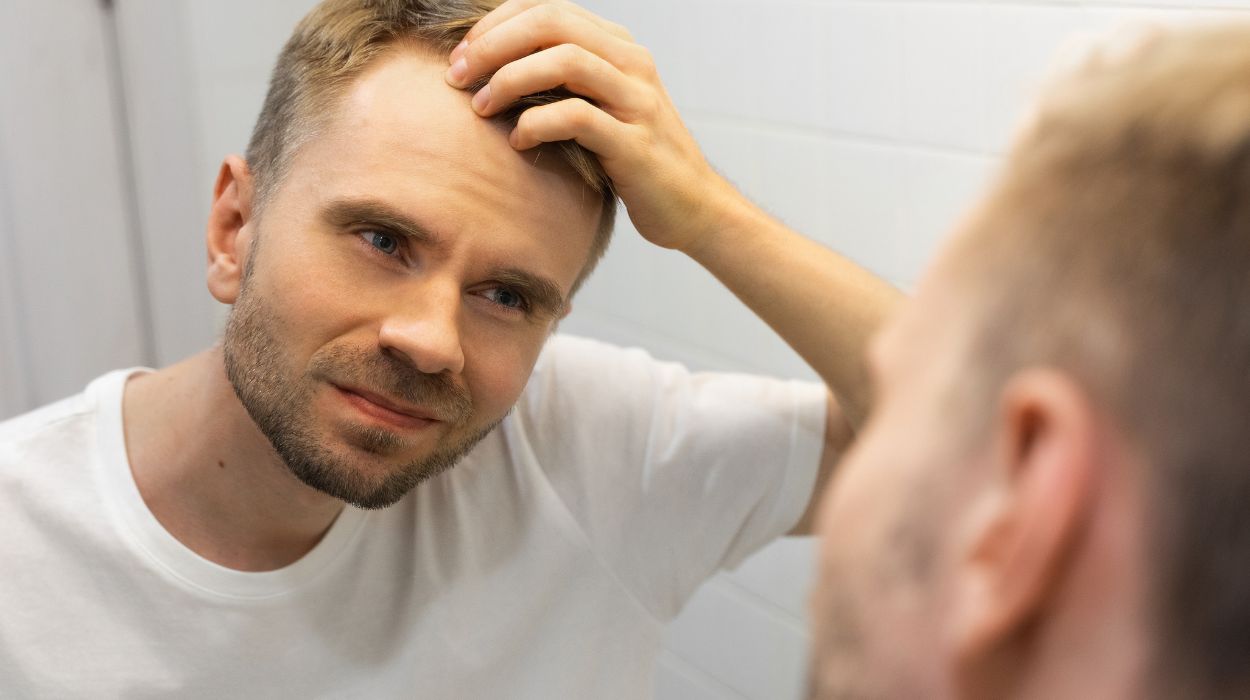 Evidence Based
Evidence Based
Evidence Based
This article is objectively based on relevant scientific literature, written by experienced medical writers, and fact-checked by a team of degreed medical experts.
Our team of registered dietitian nutritionists and licensed medical professionals seek to remain objective and unbiased while preserving the integrity of any scientific debate.
The articles contain evidence-based references from approved scientific sites. The numbers* in parentheses (*1,2,3) will take you to clickable links to our reputable sources.
Receding Hairline: Symptoms, Causes & How To Treat In 2024

It’s common for individuals to look in the mirror one day and notice their hairline creeping back. This realization can be quite distressing, especially if you’re unsure why it’s happening.
Receding hairlines are a prevalent issue. It affects many people worldwide. Still, it is more common in men. Research shows that 80% of men develop receding hair before age 80.[1] Also, about 50% of women experience it by menopause.[2] Here, we will delve into the symptoms and causes of a receding hairline, helping you to understand this condition better. We will see how to stop a receding hairline, exploring the different hair loss treatment options available.
Receding Hairline: Key Takeaway
- Receding hairline is a common condition influenced by genetics, hormones, and aging
- The condition is more common in men, but women can also experience it.
- A receding hairline may lead to a more prominent forehead and a change in the overall appearance of the hairline.
- Various treatment options are available to manage or address a receding hairline, including topical medications, hair transplant surgery, and lifestyle changes.
- Consulting with a dermatologist or hair specialist can provide personalized advice and treatment options tailored to individual needs.
What Is A Receding Hairline?
A receding hairline is a type of hair loss. It happens when the hair at the temples and forehead starts to thin and gradually move backward, creating an M or V-shaped hairline.
Receding hairline is a common issue for both men and women. However, it is more prevalent in men due to genetic factors and hormonal changes, such as increased levels of dihydrotestosterone.
Receding Hairline Symptoms
A receding hairline is a typical pattern of hair loss in which the hairline gradually moves backward from its original position. This can result in a more pronounced forehead and a V-shaped or M-shaped pattern on the scalp.
It is one of the early signs of male pattern baldness, also known as androgenetic alopecia.[3] It is different from female pattern hair loss, which is usually recognized by more diffuse hair loss around the scalp.
Here are some common signs of a receding hairline:
- Gradual hairline regression: The hairline recurs over time, usually beginning at the temples and gradually moving backward.
- Thinning hair: There may also be thinning of hair[4] on the crown or top of the head. The hair becomes finer and less dense in these areas.
- Formation of an M or V shape: The receding hairline often takes on a distinct form, resembling either an M or a V pattern, depending on the extent of hair loss.
- Increased shedding: People with a receding hairline may notice more hair shedding than usual, particularly when washing, combing, or styling their hair.
Causes Of Receding Hairline
Generally, a receding hairline can be attributed to various factors. So, understanding the root cause of your receding hairline is crucial in finding an effective treatment plan. These are the most common causes of a receding hairline:
- Genetics: Hereditary factors[1] play a significant role in hair loss. If your family has a history of hair loss or receding hairlines, you might be prone to experiencing it yourself.
- Hormonal Changes: Hormonal imbalances,[5] such as fluctuations in testosterone and dihydrotestosterone, otherwise known as DHT, can affect hair follicle health and contribute to hair loss. DHT, a derivative of testosterone, is known to shrink hair follicles,[6] leading to a receding hairline.
- Age: You may not have a receding hairline at 20, but as you age, the hair naturally starts to thin and becomes more prone to hair loss. This process is known as senescent alopecia.[7]
- Stress: Prolonged stress can lead to a type of hair loss called telogen effluvium.[8] This results in increased shedding and may contribute to a receding hairline.
- Medications: Medications,[9] such as those used to treat cancer, depression, or high blood pressure, can cause hair loss as a side effect.
Stages Of Receding Hairline

Based on the Hamilton-Norwood classification system, there are seven typical comprehensive stages[10] for males. The stages describe the extent and pattern of hair loss on the scalp, from minimal recession at the temples to complete baldness on the top of the head. Here are the stages:
The Mature Hairline
The hairline remains relatively normal initially, with a slight recession on the sides of the head above the temples. This is considered a natural age-related progression rather than a receding hairline.
Minor Recession
During stage two, the hairline recurs slightly more, creating a subtle shape. The recession may be more noticeable on the temples, with the hairline forming a shallow M shape.
Noticeable Recession
In stage three, the receding hairline becomes more pronounced. The temple areas show further signs of hair loss. The M-shape becomes more apparent, and the frontal region may have thinning or hair loss.
Significant Recession
The hairline recession becomes more noticeable by stage four and advances into the frontal area. The temples may show more significant hair thinning or bald patches. The M shape becomes more prominent, and the overall hair density decreases. Many people seek solutions to address their receding hairline during this stage.
Extensive Recession
The recession continues progressing at this stage, and the hairline recedes even further into the frontal area. The temples may appear significantly thinner or bald. The hair density on the top of the scalp may continue to decrease, resulting in a more pronounced balding appearance.
Advanced Recession
Stage six represents a more advanced and severe form of a receding hairline. The frontal area experiences extensive hair loss, including the temples and the middle of the scalp. The remaining hair may become thinner and finer, making it difficult to style or conceal the balding areas.
Near Total Recession
At this final stage, the hairline has receded significantly, and only a narrow band of hair may remain on the sides and back of the scalp. Most of the frontal area and the top of the head are bald, and the hair loss is severe.
How To Stop Receding Hairline

Stopping or reversing a receding hairline depends on the underlying cause. Much of the time, a receding hairline results in permanent hair loss. So, while stopping a receding hairline completely may not always be possible, several strategies and treatments may help slow down further hair loss.
Here are some options to treat hair loss and a receding hairline:
Medications
Two major medications treat receding hairlines in women and men:[11] finasteride and minoxidil.
- Finasteride: This prescription medication[12] helps block the conversion of testosterone to DHT, a hormone that contributes to hair loss. It can effectively slow down hair loss and promote hair growth.
- Minoxidil: OTC minoxidil[13] is a topical solution or foam applied directly to the scalp. Although results vary among individuals, it may help slow down hair loss and promote hair regrowth.
Low-Level Laser Therapy
LLLT devices emit red light at a specific wavelength[14] that stimulates hair growth. These devices are available as combs, helmets, or caps and can be used at home. LLLT may help promote hair growth and slow down hair loss.
Platelet-Rich Plasma Therapy
PRP therapy involves injecting a concentrated solution of platelets derived from the patient’s blood into the scalp. Platelets contain growth factors that may stimulate hair growth[15] and improve hair density. A medical professional performs this treatment.
Hair Transplant Surgery
Hair transplants involve removing healthy hair follicles from a donor area and implanting them[16] into the areas affected by hair loss. This procedure can be effective in treating hair loss and restoring a receding hairline, but it is a surgical procedure that should be discussed with a qualified hair transplant surgeon.
Receding Hairline Haircut
Aside from getting treatment, you can also get a receding hairline haircut. Many haircuts can help conceal a receding hairline. Some popular ones include Brushed Back Hair and High Fade Haircut.
Preventing Hair Loss
While preventing hair loss entirely may not be possible, several strategies can help slow down the gradual hair loss process. Follow these tips for healthy hair and to prevent receding hairline:
- Maintain a balanced diet: Eating a nutritious diet[17] can contribute to healthy hair. Ensure you get enough vitamins, minerals, and proteins in your balanced diet.
- Be gentle with your hair: Avoid harsh brushing or combing, especially when wet, as it is more vulnerable to damage.
- Avoid tight hairstyles: Pulling your hair tightly into ponytails, braids, or buns can cause tension and stress the hair follicles, leading to traction alopecia.[18] Opt for looser hairstyles and avoid using hair accessories that can pull on the hair.
- Avoid tobacco and limit alcohol consumption: Smoking and excessive alcohol consumption have been associated with hair loss.[19] Quit smoking if you’re a smoker, and consume alcohol in moderation.
- Regular scalp care: Keep your scalp clean and healthy by regularly washing your hair with a mild shampoo. Only use beneficial hair products.
The Bottom Line
A receding hairline is a common type of male pattern hair loss that can result in permanent hair loss. However, you can take steps to slow hair recession and, in some cases, even reverse hair loss.
If you’re experiencing a loss of hair density or have concerns about a receding hairline, talk with your dermatologist about a treatment plan. In the meantime, follow the guidelines above to avoid thin hair and increase hair growth.
+ 19 sources
Health Canal avoids using tertiary references. We have strict sourcing guidelines and rely on peer-reviewed studies, academic researches from medical associations and institutions. To ensure the accuracy of articles in Health Canal, you can read more about the editorial process here
- Hagenaars, S.P., Hill, W.G., Harris, S.E., Ritchie, S.J., Davies, G., Liewald, D.C., Gale, C.R., Porteous, D.J., Deary, I.J. and Marioni, R.E. (2017). Genetic prediction of male pattern baldness. [online] 13(2), pp.e1006594–e1006594. doi:https://doi.org/10.1371/journal.pgen.1006594.
- Tee Wei Siah, Llorenia Muir-Green and Shapiro, J. (2016). Female pattern hair loss: A retrospective study in a tertiary referral center. [online] 8(2), pp.57–57. doi:https://doi.org/10.4103/0974-7753.188033.
- Lolli, F., Pallotti, F., Alfredo De Rossi, Maria Caterina Fortuna, Caro, G., Lenzi, A., Sansone, A. and Lombardo, F. (2017). Androgenetic alopecia: a review. [online] 57(1), pp.9–17. doi:https://doi.org/10.1007/s12020-017-1280-y.
- Singal, A., Sidharth Sonthalia and Verma, P. (2013). Female pattern hair loss. [online] 79(5), pp.626–626. doi:https://doi.org/10.4103/0378-6323.116732.
- Grymowicz, M., Rudnicka, E., Agnieszka Podfigurna, Napierała, P., Smolarczyk, R., Katarzyna Smolarczyk and Blazej Meczekalski (2020). Hormonal Effects on Hair Follicles. [online] 21(15), pp.5342–5342. doi:https://doi.org/10.3390/ijms21155342.
- Yeong Chan Ryu, Park, J., Kim, Y.-R., Choi, S., Kim, G.-U., Kim, E., Hwang, Y., Kim, H., Han, G., Lee, S.-H. and Kang Yell Choi (2023). CXXC5 Mediates DHT-Induced Androgenetic Alopecia via PGD2. [online] 12(4), pp.555–555. doi:https://doi.org/10.3390/cells12040555.
- Paradi Mirmirani (2015). Age-related hair changes in men: Mechanisms and management of alopecia and graying. [online] 80(1), pp.58–62. doi:https://doi.org/10.1016/j.maturitas.2014.10.008.
- Asghar, F., Shamim, N., Umar Farooque, Sheikh, H. and Aqeel, R. (2020). Telogen Effluvium: A Review of the Literature. [online] doi:https://doi.org/10.7759/cureus.8320.
- Haslam, I.S. and Smart, E. (2019). Chemotherapy-Induced Hair Loss: The Use of Biomarkers for Predicting Alopecic Severity and Treatment Efficacy. [online] 14, p.117727191984218-117727191984218. doi:https://doi.org/10.1177/1177271919842180.
- Gupta, M. and Mysore, V. (2016). Classifications of patterned hair loss: a review. [online] 9(1), pp.3–3. doi:https://doi.org/10.4103/0974-2077.178536.
- Manabe, M., Tsuboi, R., Itami, S., Osada, S.-I., Yasuyuki Amoh, Ito, T., Shigeki Inui, Ueki, R., Manabu Ohyama, Kurata, S., Kono, T., Saito, N., Sato, A., Shimomura, Y., Nakamura, M., Hiroshi Narusawa and Yamazaki, M. (2018). Guidelines for the diagnosis and treatment of male-pattern and female-pattern hair loss, 2017 version. [online] 45(9), pp.1031–1043. doi:https://doi.org/10.1111/1346-8138.14470.
- Gupta, A., Venkataraman, M., Mamunur Rashid Talukder and Bamimore, M.A. (2021). Finasteride for hair loss: a review. [online] 33(4), pp.1938–1946. doi:https://doi.org/10.1080/09546634.2021.1959506.
- Poonkiat Suchonwanit, Sasima Thammarucha and Kanchana Leerunyakul (2019). Minoxidil and its use in hair disorders: a review. [online] Volume 13, pp.2777–2786. doi:https://doi.org/10.2147/dddt.s214907.
- Zarei, M., Wikramanayake, T.C., Leyre Falto-Aizpurua, Schachner, L.A. and Jimenez, J.J. (2016). Low level laser therapy and hair regrowth: an evidence-based review. [online] 31(2), pp.363–371. doi:https://doi.org/10.1007/s10103-015-1818-2.
- Justicz, N., Adeeb Derakhshan, Chen, J.X. and Lee, L. (2020). Platelet-Rich Plasma for Hair Restoration. [online] 28(2), pp.181–187. doi:https://doi.org/10.1016/j.fsc.2020.01.009.
- Jimenez, F., Alam, M., Vogel, J.A. and Avram, M.R. (2021). Hair transplantation: Basic overview. [online] 85(4), pp.803–814. doi:https://doi.org/10.1016/j.jaad.2021.03.124.
- O’Connor, K.E. and Goldberg, L.J. (2021). Nutrition and hair. [online] 39(5), pp.809–818. doi:https://doi.org/10.1016/j.clindermatol.2021.05.008.
- Pulickal JK;Kaliyadan F (2022). Traction Alopecia. [online] Available at: https://pubmed.ncbi.nlm.nih.gov/29262008/
- Ying Xiu Dai, Yeh, F.-Y., Shen, Y., Tai, Y., Yiing Jenq Chou, Yun Sil Chang, Li, C.-P. and Wu, C.-Y. (2020). Cigarette Smoking, Alcohol Consumption, and Risk of Alopecia Areata: A Population-Based Cohort Study in Taiwan. [online] 21(6), pp.901–911. doi:https://doi.org/10.1007/s40257-020-00547-7.



